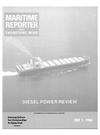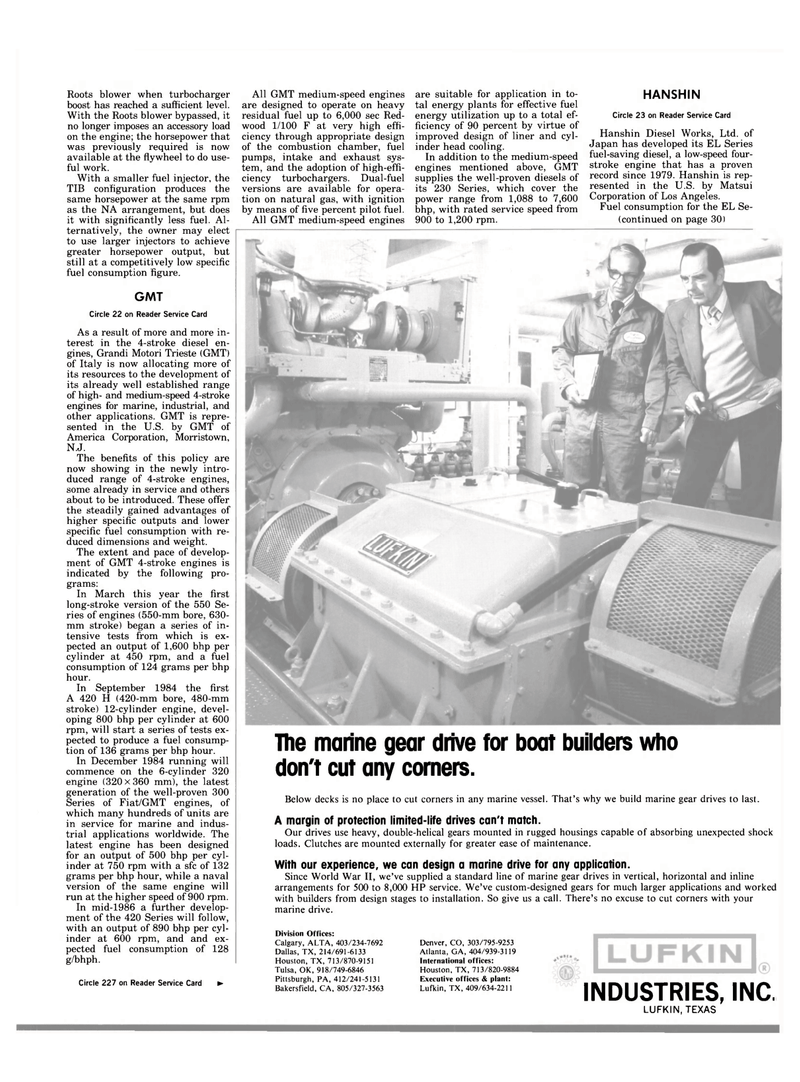
Page 25: of Maritime Reporter Magazine (July 1984)
Read this page in Pdf, Flash or Html5 edition of July 1984 Maritime Reporter Magazine
Roots blower when turbocharger boost has reached a sufficient level.
With the Roots blower bypassed, it no longer imposes an accessory load on the engine; the horsepower that was previously required is now available at the flywheel to do use- ful work.
With a smaller fuel injector, the
TIB configuration produces the same horsepower at the same rpm as the NA arrangement, but does it with significantly less fuel. Al- ternatively, the owner may elect to use larger injectors to achieve greater horsepower output, but still at a competitively low specific fuel consumption figure.
GMT
Circle 22 on Reader Service Card
As a result of more and more in- terest in the 4-stroke diesel en- gines, Grandi Motori Trieste (GMT) of Italy is now allocating more of its resources to the development of its already well established range of high- and medium-speed 4-stroke engines for marine, industrial, and other applications. GMT is repre- sented in the U.S. by GMT of
America Corporation, Morristown,
N.J.
The benefits of this policy are now showing in the newly intro- duced range of 4-stroke engines, some already in service and others about to be introduced. These offer the steadily gained advantages of higher specific outputs and lower specific fuel consumption with re- duced dimensions and weight.
The extent and pace of develop- ment of GMT 4-stroke engines is indicated by the following pro- grams:
In March this year the first long-stroke version of the 550 Se- ries of engines (550-mm bore, 630- mm stroke) began a series of in- tensive tests from which is ex- pected an output of 1,600 bhp per cylinder at 450 rpm, and a fuel consumption of 124 grams per bhp hour.
In September 1984 the first
A 420 H (420-mm bore, 480-mm stroke) 12-cylinder engine, devel- oping 800 bhp per cylinder at 600 rpm, will start a series of tests ex- pected to produce a fuel consump- tion of 136 grams per bhp hour.
In December 1984 running will commence on the 6-cylinder 320 engine (320 x 360 mm), the latest generation of the well-proven 300
Series of Fiat/GMT engines, of which many hundreds of units are in service for marine and indus- trial applications worldwide. The latest engine has been designed for an output of 500 bhp per cyl- inder at 750 rpm with a sfc of 132 grams per bhp hour, while a naval version of the same engine will run at the higher speed of 900 rpm.
In mid-1986 a further develop- ment of the 420 Series will follow, with an output of 890 bhp per cyl- inder at 600 rpm, and and ex- pected fuel consumption of 128 g/bhph.
Circle 227 on Reader Service Card •
All GMT medium-speed engines are designed to operate on heavy residual fuel up to 6,000 sec Red- wood 1/100 F at very high effi- ciency through appropriate design of the combustion chamber, fuel pumps, intake and exhaust sys- tem, and the adoption of high-effi- ciency turbochargers. Dual-fuel versions are available for opera- tion on natural gas, with ignition by means of five percent pilot fuel.
All GMT medium-speed engines are suitable for application in to- tal energy plants for effective fuel energy utilization up to a total ef- ficiency of 90 percent by virtue of improved design of liner and cyl- inder head cooling.
In addition to the medium-speed engines mentioned above, GMT supplies the well-proven diesels of its 230 Series, which cover the power range from 1,088 to 7,600 bhp, with rated service speed from 900 to 1,200 rpm.
HANSHIN
Circle 23 on Reader Service Card
Hanshin Diesel Works, Ltd. of
Japan has developed its EL Series fuel-saving diesel, a low-speed four- stroke engine that has a proven record since 1979. Hanshin is rep- resented in the U.S. by Matsui
Corporation of Los Angeles.
Fuel consumption for the EL Se- (continued on page 30)
The marine gear drive for boat builders who don't cut any corners.
Below decks is no place to cut corners in any marine vessel. That's why we build marine gear drives to last.
A margin of protection limited-life drives can't match.
Our drives use heavy, double-helical gears mounted in rugged housings capable of absorbing unexpected shock loads. Clutches are mounted externally for greater ease of maintenance.
With our experience, we can design a marine drive for any application.
Since World War II, we've supplied a standard line of marine gear drives in vertical, horizontal and inline arrangements for 500 to 8,000 HP service. We've custom-designed gears for much larger applications and worked with builders from design stages to installation. So give us a call. There's no excuse to cut corners with your marine drive.
Division Offices:
Calgary, ALTA, 403/234-7692
Dallas, TX, 214/691-6133
Houston, TX, 713/870-9151
Tulsa, OK, 918/749-6846
Pittsburgh, PA, 412/241-5131
Bakersfield, CA, 805/327-3563
Denver, CO, 303/795-9253
Atlanta, GA, 404/939-3119
International offices:
Houston, TX, 713/820-9884
Executive offices & plant:
Lufkin, TX, 409/634-2211 INDUSTRIES, INC.
LUFKIN, TEXAS

 24
24

 26
26
